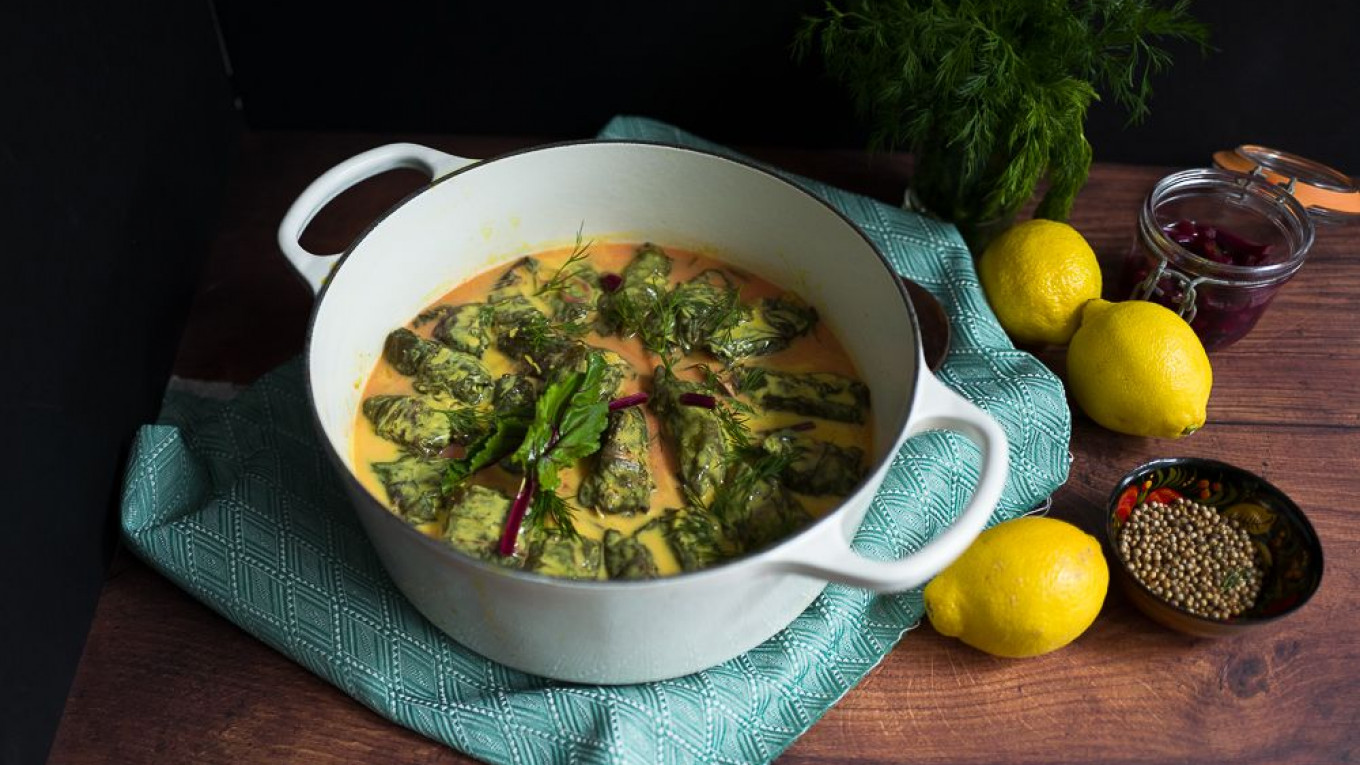Since antiquity cooks have tucked meat and grains in vegetable leaves: wrapping food in pickled fig leaves was common in both Greece and Rome. The Byzantines used vine leaves as their primary wrapper, and this mania in Asia Minor for stuffing one food into another led to the ubiquitous dolmas, small vine leaf logs stuffed with meat, rice, grains, and vegetables, which are served either hot or cold, depending on where you are.
As Byzantine culture and religion spread across Eastern Europe and into the land of the Slavs and the Balkans, dolmas rolled in its wake. As culinary culture moved north away from vine-growing regions, creative cooks looked for other pliable leaves to stuff, and happened upon cabbage, also a Byzantine import.
But stuffed cabbage leaves were not confined to the trade routes to and from Constantinople. A similar dish, Jewish holishkes, which dates back at least two and a half millennia, traveled with a diaspora on the move west, introducing sweeter notes of raisins and brown sugar. At the other end of Europe, the popularity in medieval France of pigeon and foie gras wrapped en paupiettes with cabbage leaves may well have migrated east — or at least its association with pigeon may have. That seems to be the origin of Polish goląbki, Ukrainian holubtsi, and Russian golubtsy, all versions of the word “pigeon.”
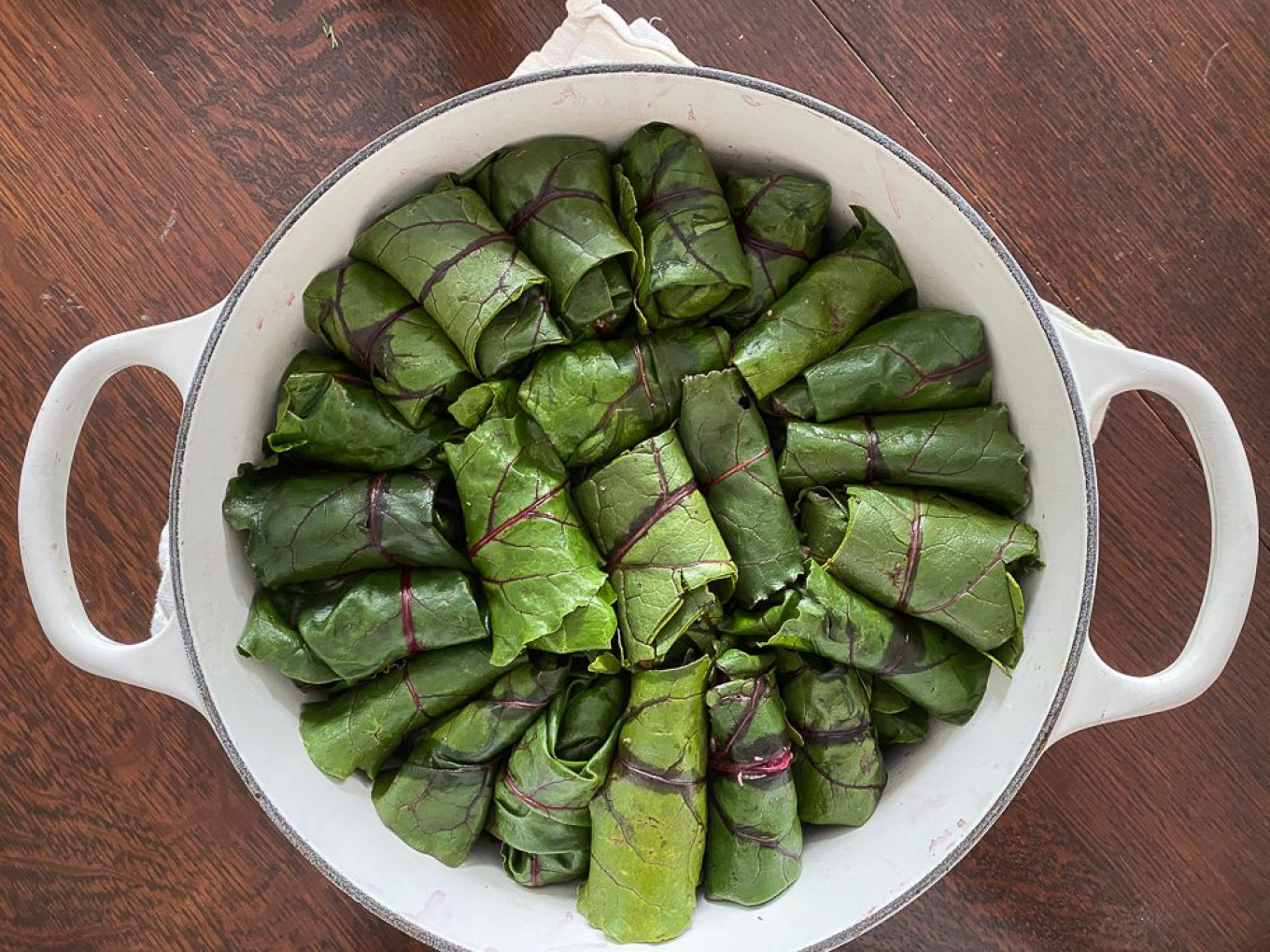
My favorite golubtsy legend, however, takes the popular dish to the extreme north of Europe. When Charles XII of Sweden lost the Battle of Poltava to Tsar Peter I, Charles fled with his armies to Turkey to convince the Sultan to join his cause. Poor Charles languished in Turkey for five years, but finally made his way back to Sweden — riding incognito, the legend says, non-stop through the Hapsburg empire until he reached his native shores. But not so incognito, it seems, that he eluded his Turkish creditors, who followed hot on his heels, all the way back to Sweden. They stayed for many years — collecting an enormous debt presumably for feeding the Swedish army for five years — and dolma-mania is their lasting legacy. Each year Swedes celebrate Kåldolmens Dag or Stuffed Cabbage Roll Day, where the rolls are served with — you guessed it! — lingonberry jam.
The thing about golubtsy is that you form an almost visceral affinity for the recipe you tried first. My Russian husband prefers the sweeter Ukrainian version with buckwheat and mushrooms, a legacy of his summers spent with relatives just outside Odessa. Perhaps your granny was from Romania, where sarmale rolls are stuffed with caramelized onion and pork and covered with a tomato and dill sauce. Or perhaps you’ve grown up having stuffed cabbage for the autumnal holiday of Simchat Torah, when the annual reading of the Torah ends and is begun again. During this holiday, two stuffed rolls represent the twin Torah scrolls.
Or maybe you’re like me and had your first taste of stuffed cabbage in the middle of stormy seas on the way to Antarctica.
My first taste of golubtsy happened in my twenties, when I worked for a luxury tour operator. Embarking on a voyage to Antarctica, we passed through the Drake Passage, where the Atlantic meets the Pacific and some of the roughest, choppiest water on the planet. None of the passengers dined that evening and the handful of staff not confined to their cabin with seasickness were directed to the officers’ mess to share our evening meal with the Greek crew. As the ship listed dangerously, a steward brought in a steaming platter of fragrant lahandolmathes, Greek stuffed cabbage with lamb and rice, smothered in a lemony sauce akin to avgolemono. The lamb and rice filling was spiked with fresh herbs and spices, and the rolls glistened with a slick of olive oil. I finished my entire plate and yearned for seconds.
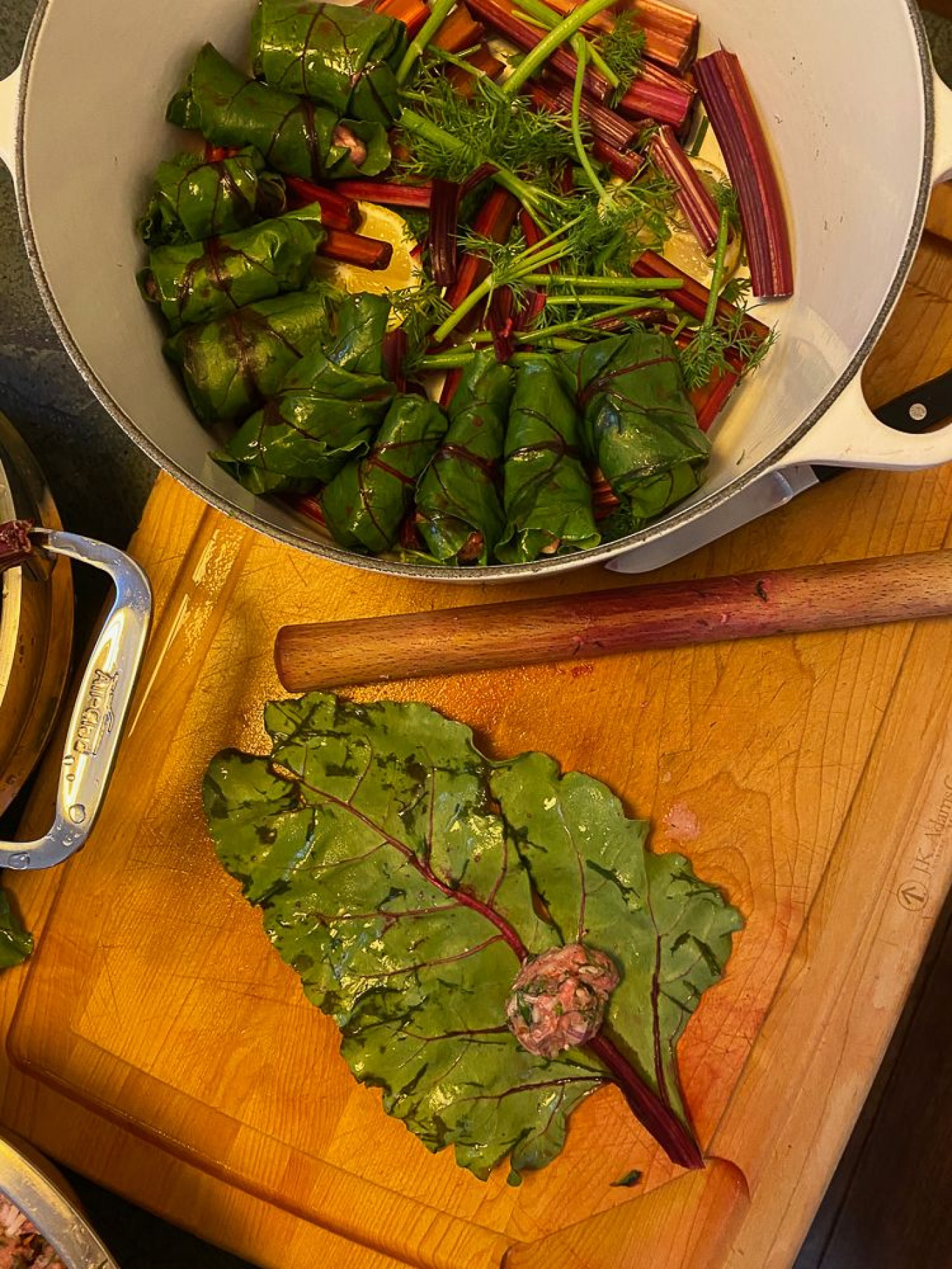
Over the years, I have had enormous fun experimenting with golubtsy. I love the quiet, almost hypnotic Zen feeling of sitting in my kitchen, rolling up the filling in the leaves, and the satisfaction of seeing them lying snug in their pot. And, of course, I love seeing the rolls disappear the minute I put a pot on the communal table. I’ve tried Ukrainian recipes, tested Russian versions, even experimented with Serbian, Moldovan, and Albanian recipes.
Here is my favorite hybrid version of golubtsy, which marries my love of Russian culinary traditions with my happy memories of the officers’ mess all those years ago. I use beet greens when I can find them as I love the taste and the color, but they can be tricky to find and to handle, so use Savoy cabbage or Swiss chard if you prefer. Feel similarly free to swap out the pork and lamb for beef, chicken, or even fish. Make it vegetarian with rice, more braised greens, carrot, and other root vegetables. To bring the dish together the lovely lemon sauce mingles with the beet stems at the end for a vibrant presentation that is a stunner on all seven continents!
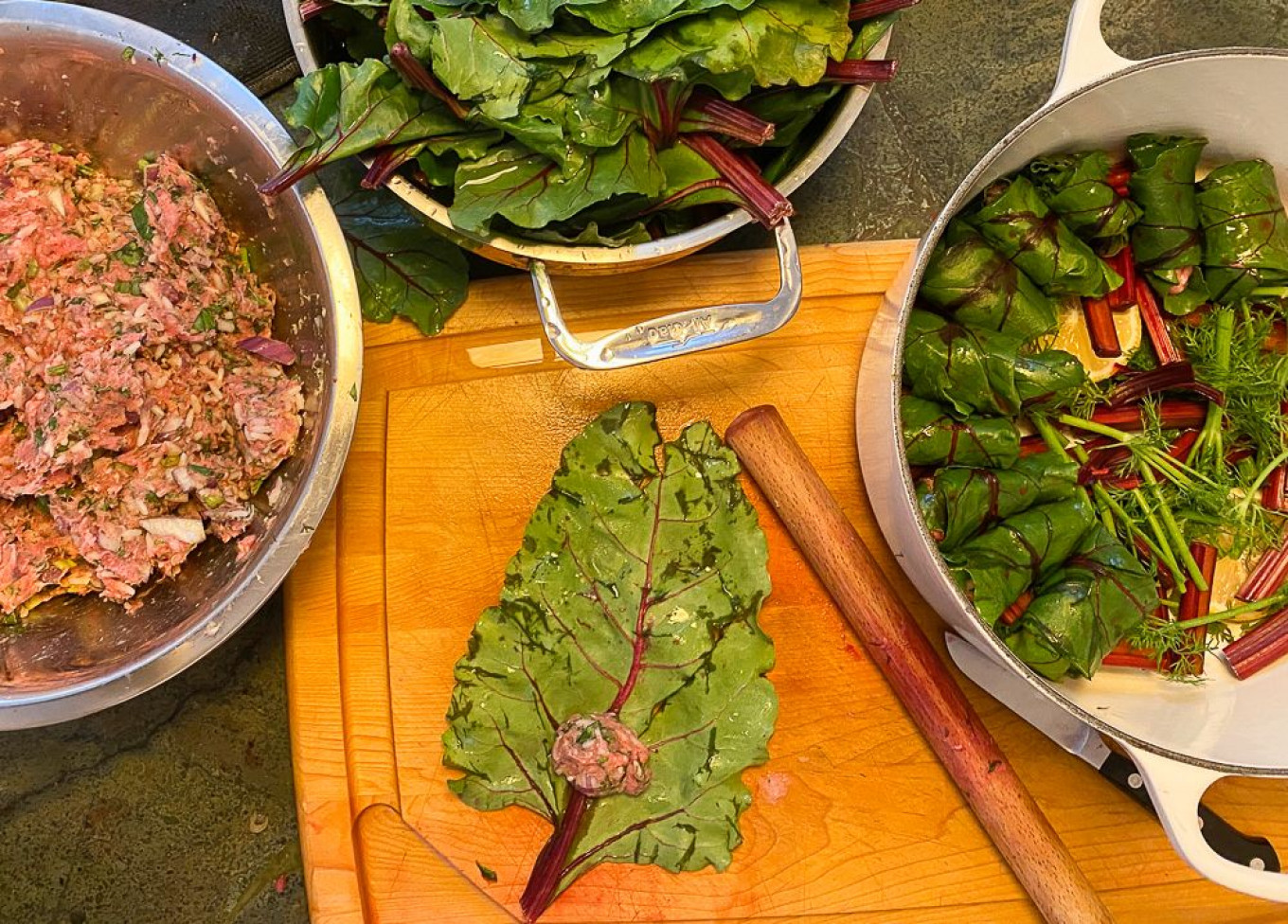
Beet Green Golubtsy with Lemon Sauce
Ingredients
- 2 tsp Aleppo pepper
- 2 tsp fennel seeds
- 2 tsp coriander seeds
- 1 Tbsp sumac
- 2 tsp sea salt
- 1 tsp fresh ground pepper
- 1 ½ cups (360 ml) cooked rice
- ¾ lb (340 grams) of ground beef or veal
- ¾ lb (340 grams) ground lamb or pork
- ½ cup (120 ml) chopped fresh parsley
- ½ cup (120 ml) chopped fresh dill
- ¼ cup (60 ml) chopped fresh mint
- 1 yellow onion, finely chopped
- 4 cloves garlic, finely chopped
- Zest of one lemon
- ¼ cup (60 ml) olive oil plus more for drizzling.
- 30-40 beet greens, thoroughly washed, stems removed or 15-25 chard leaves, removed from their stems
- 4 cups (1 liter) chicken or vegetable stock
For the “trivet”
- ½ cup (120 ml) beet stems, washed and cut into 2-inch matchsticks
- ¼ cup (60 ml) dill stems, cut into 2-inch slices
- 1 lemon, cut into slices
- 2 Tbsp olive oil
For the sauce
- 4 egg yolks
- Juice of 2 lemons
- 2 Tbsp cornstarch
- 2 Tbsp butter
- ⅔ cup (160 ml) sour cream
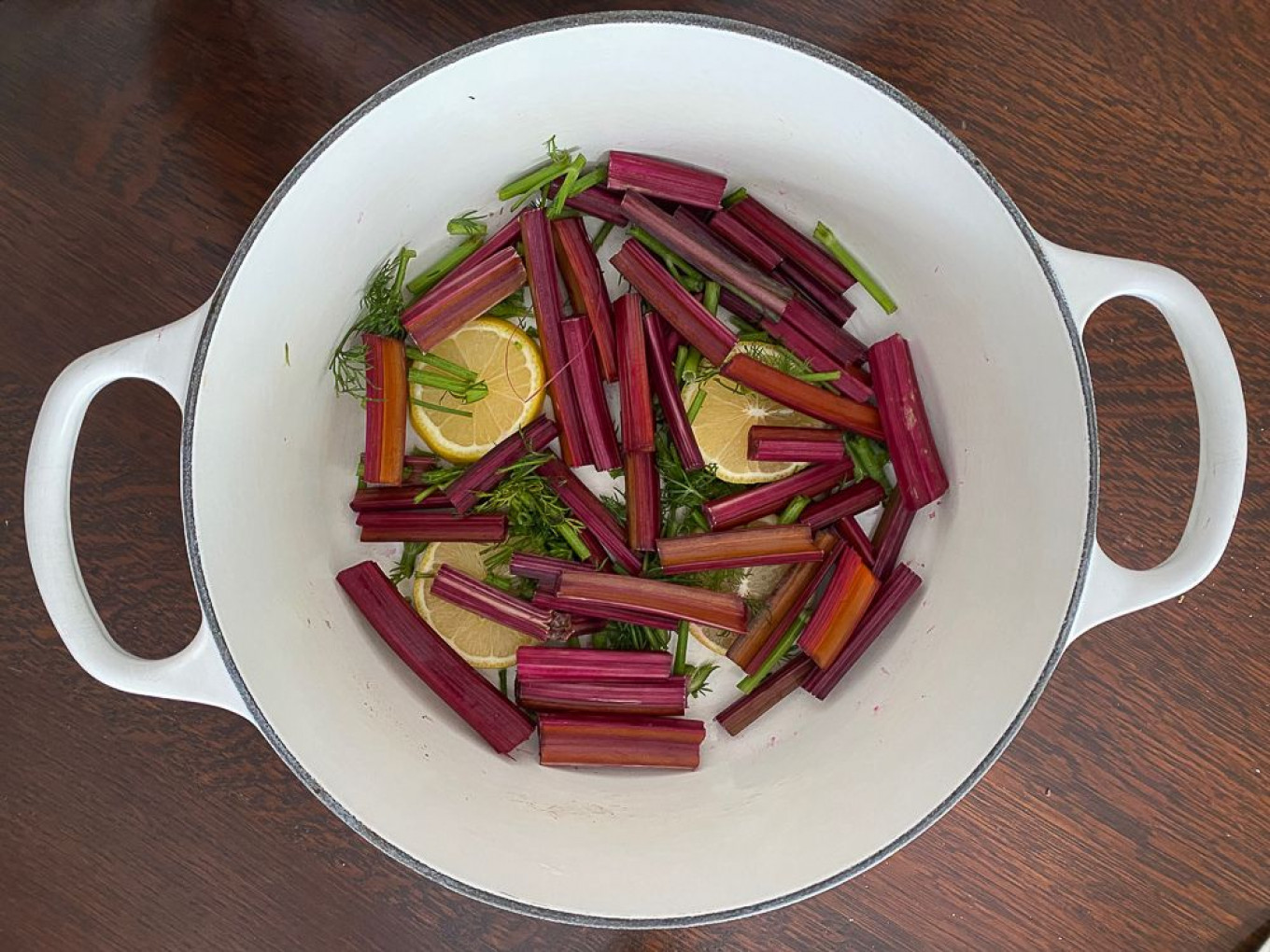
Instructions
- Toast the coriander seeds, fennel seeds, sumac, and Aleppo pepper in a skillet over medium heat their flavor is amplified. Cool to room temperature and grind in a spice grinder or with a mortar and pestle.
- Combine the ground meat, onion, garlic, rice, fresh herbs, salt, pepper, olive oil, and ground spices in a large, non-reactive bowl. Knead the mixture together well with your hands. Cover with plastic wrap and set aside for 30 minutes to allow the flavors to develop.
- Prepare the pot: Brush a Dutch oven or stockpot with olive oil, then arrange the beet and dill stems and lemon slices into a “trivet” on the bottom of the pot. This will ensure the golubtsy don’t stick to the bottom and allow the liquid to circulate freely.
- Prepare the beet greens: Choose large beet greens that are neither torn nor discolored. If you are using chard leaves, slice them from the stem. Stack the greens in a colander and pour a large pot of boiling water over them. Blot each green dry gently with a paper towel before you stuff it. Use a small dumpling rolling pin or drinking glass to soften the beet green stem by rolling over it a few times.
- Place a teaspoon of the filling at the base of the beet green. Fold the short ends in sideways over the filling, then roll up the beet green along the long plane into a small log. Place each roll, seam side down in the prepared pot, nestling them together. Depending on the size of your pot, you should have 2 or 3 layers. Drizzle a few teaspoons of olive oil on a completed layer before you begin the next layer.
- When you have filled the pot, place any spare beet leaves you have left on the top layer. Then place a plate on top of the pot to weigh down the rolls. Carefully pour the stock down the side of the pot until it reaches the plate.
- Bring the pot to a careful simmer over medium low heat — you don’t want a rolling boil for this. Cover the pot and cook over low heat for 35 minutes.
- When the golubtsy have cooked for 35 minutes, remove from the heat. Carefully decant 4 cups (one liter) of stock from the pot, taking care not to dislodge the golubtsy. Set aside for the sauce and let it cool slightly. Keep the golubtsy covered in warm oven, or over the lowest possible heat on the stovetop.
- Whisk together the corn starch and two tablespoons of warm water into a slurry. Add the lemon juice to the decanted stock. Whisk together the egg yolks in a large saucepan, then slowly pour the stock and lemon juice mixture into the eggs, whisking constantly as you do.
- Place the saucepan with the egg and stock mixture over low heat and whisk in the cornstarch slurry. Stir continuously as the mixture thickens. When it appears glossy and clings to the back of a spoon, add the butter and whisk until incorporated. Finish the sauce with the sour cream, whisking to combine.
- Remove the beet greens from the top of the pot, and pour the finished sauce into the pot, taking care not to dislodge the golubtsy.
- Serve the golubtsy hot with generous amounts of sauce, lots of fresh dill, some of the trivet vegetables, and some fresh ground black pepper. I like to serve this with plenty of flatbread to soak up the heavenly sauce.
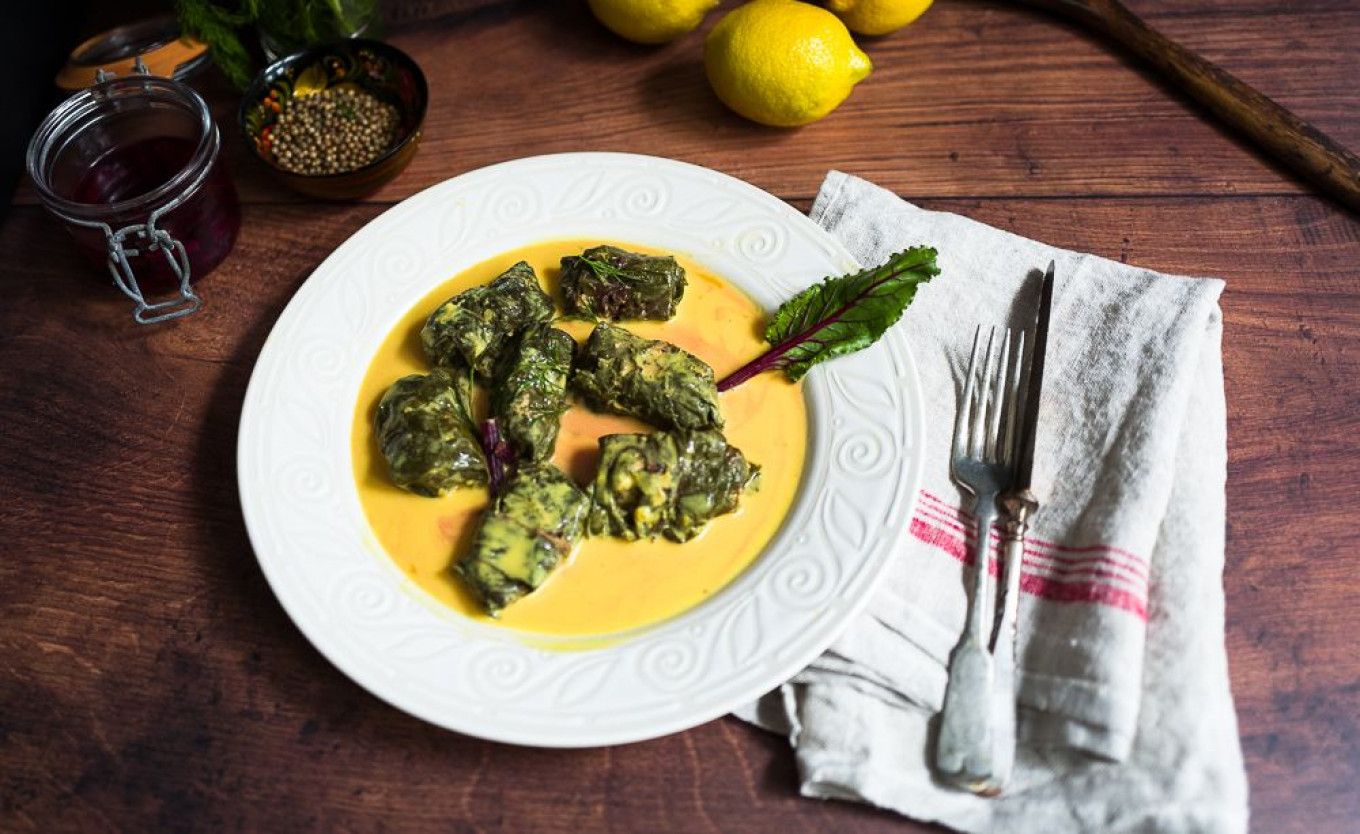
A Message from The Moscow Times:
Dear readers,
We are facing unprecedented challenges. Russia's Prosecutor General's Office has designated The Moscow Times as an "undesirable" organization, criminalizing our work and putting our staff at risk of prosecution. This follows our earlier unjust labeling as a "foreign agent."
These actions are direct attempts to silence independent journalism in Russia. The authorities claim our work "discredits the decisions of the Russian leadership." We see things differently: we strive to provide accurate, unbiased reporting on Russia.
We, the journalists of The Moscow Times, refuse to be silenced. But to continue our work, we need your help.
Your support, no matter how small, makes a world of difference. If you can, please support us monthly starting from just $2. It's quick to set up, and every contribution makes a significant impact.
By supporting The Moscow Times, you're defending open, independent journalism in the face of repression. Thank you for standing with us.
Remind me later.



